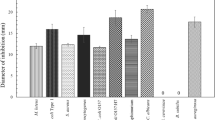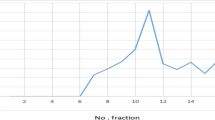Abstract
The molecular mass of the purified killer toxin from the marine killer yeast YF07b was estimated to be 47.0 kDa. The optimal pH and temperature of the purified killer toxin were 4.5 and 40°C, respectively. The toxin was activated by Ca2+, K+, Na+, Mg2+, Na+, and Co2+. However, Fe2+, Fe3+, Hg2+, Cu2+, Mn2+, Zn2+, and Ag+ acted as inhibitors in decreasing activity of the toxin. The toxin was strongly inhibited by phenylmethanesulphonyl fluoride (PMSF), iodoacetic acid, ethylenediaminetetraacetic acid, and 1,10-phenanthroline. The Km of the toxin for laminarin was 1.17 g L−1. The toxin also actively hydrolyzed laminarin and killed the whole cells of the pathogenic yeast in crab.






Similar content being viewed by others
References
Barth G, Gaillardin C (1997) Physiology and genetics of the dimorphic fungus Yarrowia lipolytica. FEMS Microbiol Rev 19:219–237
Bradford MM (1976) A rapid and sensitive method for the quantitation of microgram quantities of protein utilizing the principle of protein-dye binding. Anal Biochem 72:248–254
George V, Diwan AM (1983) Simultaneous staining of proteins during polyacrylamide gel electrophoresis in acidic gels by countermigration of Coomassie brilliant blue R-250. Anal Biochem 132:481–483
Gong F, Sheng J, Chi ZM, Li J (2007) Inulinase production by a marine yeast Pichia guilliermondii and inulin hydrolysis by the crude inulinase. J Ind Microbiol Biotechnol 34:179–185
Izgu F, Altınbay D, Sertkaya A (2005) Enzymic activity of the K5-type yeast killer toxin and its characterization. Biosci Biotechnol Biochem 69:2200–2206
Izgu F, Altınbay D, Acun T (2006) Killer toxin of Pichia anomala NCYC 432; purification, characterization and its exo-β-1,3-glucanase activity. Enzyme Microb Tech 39:669–676
Kashiwagi T, Kunishima N, Suzuki C, Tsuchiya F, Nikkuni S, Arata Y, Morikawa K (1997) The novel acidophilic structure of the killer toxin from halotolerant yeast demonstrates remarkable folding similarity with a fungal killer toxin. Structure 5:81–93
Laemmli UK (1970) Cleavage of structural proteins during the assembly of the head of bacteriophage T4. Nature 227:680–685
Ma CL, Ni XM, Chi ZM, Ma LY, Gao LM (2007) Purification and characterization of an alkaline protease from the marine yeast Aureobasidium pullulans for bioactive peptide production from different sources. Mar Biotechnol 9:343–351
Moore MM, Strom MB (2003) Infection and mortality by the yeast Metschnikowia bicuspidata var, bicuspidate in Chinook salmon fed live adult brine shrimp (Artemia franciscana). Aquaculture 220:43–57
Ramirez-Zavala B, Mercado-Flores Y, Hernadez-Rodriguez C, Villa-Tanaca L (2004) Purification and characterization of lysine aminopeptidase from Kluyveromyces marxiamus. FEMS Microbiol Lett 235:369–375
Santos A, Marquina D, Leal JA, Peinado JM (2000) (1,6)-β-D-glucan as cell wall receptor for Pichia membranifaciens killer toxin. Appl Environ Microbiol 66:1809–1813
Sharon C, Furugoh S, Yamakido T, Ogawa H, Kato Y (1998) Purification and characterization of a lipase from Pseudomonas aeruginosa KKA-5 and its role in castor oil hydrolysis. J Ind Microbiol Biotechnol 20:304–307
Spiro RG (1966) Analysis of sugars found in glycoproteins. Method Enzymol 8:3–26
Sun YH, Sun QH (1998) Studies on pathogenic organism and prevention and cure for explosive epidemic disease of parent prawn of Macrobrachium rosenbergh. J Fish China 22:56–60
Tong SL, Miao HZ (1999) A new species of marine yeast Kluyveromyces penaeid isolated from the heart of penaeid shrimp Pennaeus chinensis. J Mar Biol Ass U K 79:559–561
Wang XH, Chi ZM, Yue LX, Li J, Li MJ, Wu LF (2007) A marine killer yeast against the pathogenic yeast strain in crab (Portunus trituberculatus) and an optimization of the toxin production. Microbiol Res 162:77–85
Acknowledgment
This research was supported by Grant 30670058 from National Natural Science Foundation of China.
Author information
Authors and Affiliations
Corresponding author
Rights and permissions
About this article
Cite this article
Wang, X., Chi, Z., Yue, L. et al. Purification and Characterization of Killer Toxin from a Marine Yeast Pichia anomala YF07b Against the Pathogenic Yeast in Crab. Curr Microbiol 55, 396–401 (2007). https://doi.org/10.1007/s00284-007-9010-y
Received:
Accepted:
Published:
Issue Date:
DOI: https://doi.org/10.1007/s00284-007-9010-y




